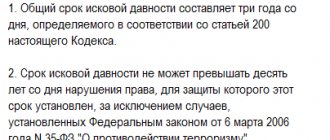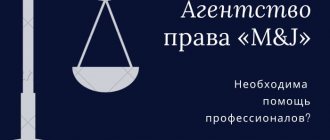Payment term according to the contract
The period during which the counterparty company undertakes to pay for goods or services depends on the existing relationship and the scope of work.
In the case of small one-time deliveries, both parties will be interested in closing the documents as quickly as possible, but if long-term cooperation is expected, involving large deliveries, long-term installments are possible.
A formed positive business image always has an extremely positive effect on the terms of cooperation of legal entities. Of course, if organizations have been cooperating for several years, the duration of the installment plan will be increased in comparison with that provided to the company with which they are working for the first time.
Article 195 of the Civil Code of the Russian Federation
Claim deadlines are the deadlines provided for by law or contract for filing a claim against an obligated person in pre-trial proceedings. The Civil Code (Clause 1, Article 797) provides that such deadlines for requirements for carriers arising from the transportation of goods are established by the relevant transport charter or code. Thus, for domestic air transportation (Article 126 VK), a claim against the carrier can be filed within 6 months. According to the APC (clause 3, article 4), a dispute can be referred to an arbitration court only after compliance with the claim procedure, if it is established by federal law or provided for by an agreement. In the practice of arbitration courts, they proceed from the fact that in order to accept a claim for consideration, when the claim procedure is provided for in the contract, the fact of filing a claim is sufficient. Failure to comply with the claim deadline does not in itself entail refusal to accept the claim for consideration. The deadlines provided for by law or contract for notification of a detected non-conformity of goods transferred under a sales contract should be distinguished from claim deadlines (clause 1 of Article 483 of the Civil Code). The consequences of non-compliance are established by law (clauses 2, 3 of Article 483). The warranty period also has a different legal nature (for purchase and sale, see, in particular, Art. 470, 471, 477).
We recommend reading: What is the tax percentage when selling an apartment?
The preclusive (preclusive) period is the period after which the right of claim itself is extinguished. After its expiration, it is impossible to obtain protection of the violated right by going to court. The Civil Code provides for such deadlines in relation to claims of creditors against the guarantor (see paragraph 4 of Article 367). The nature of the deadline for the beneficiary to submit a claim under a bank guarantee is similar (clause 2 of Article 374). Such deadlines are also established in the Regulations on bills of exchange and promissory notes (Article 70). As noted above (see paragraph 4 of the introductory commentary to this chapter), the question of whether the deadlines provided for by the Civil Code for claims from checks (paragraph 3 of Article 885) requires additional clarification.
Types of limitation periods according to the Civil Code
- Limitation of actions
This is the period provided for pre-trial settlement of the dispute before filing a claim with the Arbitration Court. During this time, you can try to come to an agreement with the debtor, negotiate and conduct claims work.
- Procedural intervals
These are periods of time relevant to the trial
- Performance terms
The deadlines for submitting a writ of execution are specified in Federal Law 229 dated December 28, 2006. These are the periods during which work is carried out to collect funds under the writ of execution.
In what cases is the limitation period not established?
Article 208 of the Civil Code defines the requirements to which the validity period of a statement of claim to the court does not apply. We are talking, in particular, about claims:
- on the protection of non-property rights, for example the right to non-interference in private life;
- to banking organizations regarding the issuance of deposits;
- on compensation for damage to life and health;
- on eliminating violations of the rights of the property owner that are not related to deprivation of possession;
- according to requirements arising from family relations (Article 9 of the Family Code).
Features of calculating the statute of limitations for debt collection
For each type of collection activity, there are time periods by law or by contract The period specified in the contract may be reasonably less than that specified by the Civil Code, but cannot exceed it. Also, the statute of limitations can be extended by a judge .
Remember that in some cases it is possible to restore the starting point of the statute of limitations, but the judge cannot influence the restoration of the statute of limitations with his decision.
Under legally defined circumstances, the statute of limitations may be suspended or interrupted. These circumstances are also described in the Civil Code.
The collection period begins on the day the creditor learned or should have learned about the overdue debt, usually one day after the end of the contractual period for fulfilling obligations.
The end of the collection period is determined depending on the specified time period:
- for years – this is the same date of the last year
- for months, quarters or half-years - this is the same day of the last month
- for days and two-week periods - this is the last day
If the last day falls on a weekend, the last day is moved to the end of Monday. The end time of the day is the end time of the organization's working day in accordance with its official work schedule.
Petition for application of limitation period
The defendant himself must be familiar with these rules of substantive law, which are used to resolve disputed legal relations, understanding the procedure used in calculating time limits (this is defined in Chapters 11-12 of the Civil Procedure Code of the Russian Federation).
Of course, it is possible to make a demand for recognition that the limitation period has expired during the preliminary consideration of the case in court, however, the latter may provide the plaintiff with the opportunity to file an appeal in order to restore the limitation period.
Limitation periods
Article 196 of the Civil Code states that the period during which a debt collection case can be filed in court, the so-called statute of limitations, is limited and happens:
- general, equal to three years
- special, increasing or decreasing the total term on the basis of regulations, but it cannot be more than 10 years
The starting date is the date of fulfillment of obligations specified in the contract. If a specific day is not specified, but the contract stipulates that the obligations are fulfilled upon first demand, the period is calculated from the day the creditor demands fulfillment of the obligations.
The limitation period specified in the Civil Code cannot be extended, but in accordance with Article 202 of the Civil Code it can:
- interrupt
- pause
- stop
Break in the limitation period
A break occurs when the debtor decides to acknowledge and voluntarily pay his obligations. Confirmation and begins the corresponding activity. If, despite the initial intentions, the debt was never paid, the statute of limitations begins again .
Suspension of the limitation period
The limitation period is suspended in cases of objective impossibility for the debtor to fulfill his obligations, and after their expiration it is not reset, but continues . After the cessation of the circumstances that have arisen, the remaining time increases to six months, if it was a shorter period.
Conditions for suspending the countdown of the statute of limitations:
- Force majeure circumstances, when filing a claim is impossible due to emergency situations or unavoidable reasons
- When one of the parties is serving in the Russian army and is in a state of war
- The fulfillment of obligations under the contract was delayed or prohibited by a moratorium imposed by the authorities
- The effect of the normative act on which the parties to the agreement relied was suspended
Subtleties of the limitation period that are important for the representative of the plaintiff or defendant to know
The second lecture by the editor of the journal of the Russian School of Private Law, professor and director of the Center for Comparative Law of the National Research University Higher School of Economics, arbitrator of the ICAC, Arbitration Center at the RSPP Andrey Egorov at the FPA webinar on May 6 was devoted to the topic “Limitation of claims: subtleties that are important for the representative of the plaintiff to know or the defendant."
At the beginning of the lecture, reports the FPA press service, Andrei Egorov recalled the main regulations that explain the provisions of the Civil Code of the Russian Federation on the limitation period. This issue was specified with amendments to subsection. 4 and 5 sections I part 1 and art. 1153 part 3 of the Civil Code of the Russian Federation in 2013
Also on September 29, 2015, the Plenum of the Supreme Court of the Russian Federation adopted Resolution No. 43 “On some issues related to the application of the provisions of the Civil Code of the Russian Federation on the limitation period.” This document consistently continues to explain the provisions of the updated Civil Code of the Russian Federation, which gives reason to once again comprehend the innovations in relation to the limitation period, as well as evaluate how such innovations are interpreted by the Plenum.
The clarifications of the highest court on the limitation period were initially proposed to be included in the Resolution of the Plenum of the Supreme Court of the Russian Federation dated June 23, 2015 No. 25 “On the application by courts of certain provisions of Section I of Part 1 of the Civil Code of the Russian Federation”, but already in the process of work it was decided to separate them into a separate document. It is also interesting to compare the newly adopted resolution with the previously valid act of interpretation - the joint Resolution of the Plenum of the Supreme Arbitration Court of the Russian Federation dated November 12, 2001 No. 15, the Plenum of the Supreme Arbitration Court of the Russian Federation dated November 15, 2001 No. 18. The previous resolution no longer applies. Therefore, it is important to understand in what part the new document retains continuity with the previous act, and which provisions of Resolution No. 15/18 and for what reasons were not accepted.
The problem of limitation of actions is one of the most complex in civil law. This is expressed, in particular, in the fact that the current version provides for a significant number of different limitation periods - both subjective and objective.
As Andrey Egorov noted, it is necessary to establish which claims are subject to the statute of limitations. First of all, the exception should concern claims for recognition. Such claims occur in relation to invalid transactions. Here it is necessary to distinguish between voidable and void transactions. When demanding to recognize a void transaction as invalid, there should be no limitation period. Courts often do not actually apply the limitation period when considering such cases, although it would seem that the Civil Code speaks about it. And this is correct, since there are issues that need to be resolved regardless of how many years have passed since her conclusion.
In his opinion, contrary to the provisions of the Family Code, limitation cannot be applied in a claim for the division of marital property, since the spouses remain co-owners of jointly acquired property. The property ownership of an asset cannot be limited by the statute of limitations. The statute of limitations is possible only for claims for award (claims). But even among claims, not all are subject to limitation. For example, there is no statute of limitations for a negative claim. True, there may be disputes when the claim is negative, and when it is vindication, for example, when a seizure (intentional or accidental) of a small part of a neighbor’s land occurs.
Having dwelled on the issue of calculating the limitation period (both objective and subjective), the expert noted that the limitation period, as a rule, begins from the day when the person learned or should have learned about the violation of his right and who is responsible defendant in a claim to protect this right. It is interesting that if in the previous wording of paragraph 1 of Art. 200 of the Civil Code of the Russian Federation for these purposes required actual or imputed knowledge of a person only about the violation of his right, but now it is also necessary to know about the person who violated (violates) such a right.
The lecturer drew attention to the fact that from September 1, 2023, questions about the objective period will become truly relevant, since 10 years will expire from the date of amendment to the Civil Code of the Russian Federation. Until this moment, the objective statute of limitations does not work, since it only applies to claims that arose after September 1, 2013. And in the subjective period, the most important thing is the moment when a person learned or supposedly should have learned about the violated right. At the same time, this phrase “should have known” is better interpreted as “could not help but find out” or “did not find out due to gross negligence.”
For obligations with a specific performance period, the limitation period begins to run upon the expiration of the performance period. And for obligations for which the deadline for fulfillment is not determined or is determined by the moment of demand, the limitation period begins to run from the day the creditor presents a demand for fulfillment of the obligation, and if the debtor is given a period for fulfilling such a requirement, the calculation of the limitation period begins at the end of the period provided for fulfillment such a requirement. In this case, the limitation period, in any case, cannot exceed 10 years from the date the obligation arose.
There is a tendency to increase the statute of limitations, noted Andrey Egorov. It is possible to delay the start of such a period or to suspend it. The first option is possible, for example, if the court does not like that the plaintiff missed the statute of limitations. Sympathizing with the plaintiff and wanting to protect his interests, the court may extend the start of this period. The second is possible due to a number of circumstances, such as an emergency and unpreventable circumstance under the given conditions (force majeure), the presence of the plaintiff or defendant in the Armed Forces of the Russian Federation, transferred to martial law, due to the established deferment of the fulfillment of obligations or suspension of the legal act regulating the relevant attitude .
The lecturer warned that the limitation period ceases to run if the claim is brought in court or if the debt is recognized by the defendant. From the date of application to the court in the prescribed manner for the protection of a violated right, the statute of limitations does not run for the entire time that the judicial protection of the violated right is carried out. As for the recognition of debt, according to the expert, there is a tendency for a restrictive interpretation of such cases in judicial practice, which is sometimes unjustified.
Regarding who exactly can declare in court that the statute of limitations has passed, Andrei Egorov believes that the Supreme Court was in vain to grant such a right to a third party. This and other examples indicate that acts of interpretation of the law also sometimes require interpretation or clarification.
At the end of the lecture, a few words were said about the statute of limitations for corporate and indirect claims. The expert, as a rule, supported his conclusions with specific and very clear examples, which made it possible to evaluate certain court decisions in which the protection of rights was denied due to the application of the statute of limitations.
The accompanying materials for the lecture can be found here.
The broadcast will be repeated on Monday, May 11.
Termination of the limitation period
Obviously, the limitation period ends when a statement of claim is filed in court. If the court decision was not made, the limitation period is renewed and continues in accordance with the general requirements.
Actions after the expiration of the statute of limitations
It is not prohibited by law to sue a debtor after the statute of limitations has expired, and the Arbitration Court such a claim for consideration In this situation, only the defendant himself can declare the expiration of the statute of limitations, and the case will be closed without satisfying the creditor's claims.
It is also legally possible to restore the time limit for filing a claim if the creditor files a motion to restore the time limit . This method can be used if, in the six months preceding the end of the statute of limitations, there were truly exceptional and valid reasons that can be documented.
In the absence of valid reasons (floods, tsunamis, earthquakes, etc.), you should forget about repaying the debt and begin the procedure of writing it off and transferring it to the category of hopeless.
Thus, paragraph 77 of the Order of the Ministry of Finance dated July 29, 1998 No. 34n and the Resolution of the Federal Antimonopoly Service of the Volga-Vyatka District dated March 9, 2006 in case No. A43-20240/2005-30-656, it was determined that bad debts that meet the following conditions are subject to write-off:
- the statute of limitations has expired (in general, the debt has been overdue for more than 3 years)
- the management of the creditor organization decided that it was impossible to receive payment
What are the deadlines for applying to a labor court?
According to Art. 391 of the Labor Code of the Russian Federation, claims filed by:
- workers with violated labor rights;
- employees reporting illegal actions of employers;
- employers who suffered damage due to the fault of a subordinate;
- citizens who have received an unlawful refusal to hire;
- citizens working for individuals who are not individual entrepreneurs;
- persons who have been discriminated against.
The statute of limitations for employees is different from the statute of limitations for employers. All of them are spelled out in Art. 392 of the Labor Code of the Russian Federation, which establishes the right to go to court for both parties, as well as the grounds for appeal.
IMPORTANT! In relation to individual labor disputes, the general provisions of civil law do not apply. In this matter, you need to be guided exclusively by the Labor Code of the Russian Federation.
Time limits for filing a lawsuit for an employee
Under Part 1 of Article 92 of the Labor Code of the Russian Federation, employees are provided with the following deadlines and grounds for going to court:
- 3 months from the date of establishment of the fact of violation of the employee’s rights or from the day when the employee should have learned about this violation;
- 1 month from the date of receipt of the work record book or dismissal order for cases of disputes regarding dismissal;
- 1 year from the date on which full cash payment is due for disputes based on non-payment or incomplete payment of wages.
Due to such short deadlines (except for the third point), as well as legal illiteracy, most workers who have labor disputes go to court late. The court is obliged to accept the statement of claim and begin proceedings in the case even after the deadline has expired. But, if on this occasion the responding party petitions for dismissal of the claim, then, unless the plaintiff has a valid reason for missing the deadline for filing the claim, the court will refuse to consider the case.
Time limits for going to court for an employer
Employers, in turn, have a longer period of time to go to court. In Part 2 of Art. 392 of the Labor Code of the Russian Federation, this period is stated as 1 year, during which the recovery of damage caused by the employee can be demanded in court. The countdown begins from the moment the damage is discovered. The application can be submitted both for employees currently on staff and for those already dismissed. In case of missing the agreed deadlines for going to court, employers must also provide a valid reason.
Performance terms
The deadlines for the company to collect funds from a creditor under a writ of execution are determined by Chapter 3 of Federal Law No. 229 of December 28, 2016 On Enforcement Proceedings.
In general, a writ of execution with an attached application to initiate enforcement proceedings can be submitted to the bailiff service within 3 years from the date the court decision enters into legal force. The statement itself is usually written when submitting a writ of execution to the relevant FSSP body.
If collection is made on the basis of a court order, it can also be presented within 3 years from the date of issue.
Since 2015, if the debtor is granted a deferment in the execution of claims by a writ of execution, the period for debt collection begins after the end of the granted deferment.
to issue a decision to initiate enforcement proceedings within 3 days Unfortunately, practice shows that the deadlines set for the actions of bailiffs are violated.
The strategy for working with bailiffs is worked out by a lawyer, since otherwise the chances of getting the money back after filing an application tend to zero.
229 The Federal Law also stipulates the deadlines given to the debtor for the voluntary fulfillment of obligations. After the initiation of enforcement proceedings, the bailiff sends to the debtor a Resolution on the initiation of enforcement proceedings indicating the possibility of a voluntary return of funds within 5 days from the date of its receipt. If the debtor received the letter, but does not repay the debt, the amount of the enforcement fee is added to the amount of the debt.
Requests for debt collection contained in the writ of execution must be executed by bailiffs within 2 months . If during this period of time it turns out that collection is impossible, for example, the debtor has disappeared, this cannot become a basis for an earlier termination of enforcement proceedings in the case.
Deadlines in enforcement proceedings, similar to the limitation periods, can be missed, restored, suspended, extended and interrupted.
If a writ of execution was issued by the Arbitration Court, by whose decision the statute of limitations for its presentation was restored, it can be used within 3 months from the date of the court decision to restore the missed deadlines.
Effective use of the nuances of legislation regarding statutes of limitations makes it possible to legally collect debts previously considered bad. Therefore, get legal advice before writing off your debt!
0
0
0
0
0
Is there a statute of limitations for enforcement proceedings?
The government agency that carries out enforcement proceedings is the Federal Bailiff Service of the Russian Federation. Issues relating to their activities are regulated by the Law on Enforcement Proceedings No. 229-FZ.
It does not contain the concept of “limitation period for enforcement proceedings”. However, in order to carry out actions for which they are authorized, bailiffs must be guided by the deadlines specified in Article 36 No. 229-FZ. They are given a two-month period from the moment of initiation of enforcement proceedings to carry out enforcement actions. The period for initiating the case is not included in the period. The rule applies when a court decision, order or other act of a court or federal law does not establish another deadline for its enforcement.
Note!
Tax and customs legislation may provide for their own deadlines for making mandatory payments.
Shortened deadlines are provided:
- when the bailiff transfers an order to another bailiff to carry out enforcement actions, to apply enforcement measures - within fifteen days from the date of receipt of the resolution, unless other deadlines are indicated in it;
- when a bailiff gives another bailiff an order to apply interim measures - it must be executed on the same day or, if impossible, the next;
- when a court decision on reinstatement is made, it must be executed immediately;
- when a court decision is made to collect alimony, pay wages to an employee for three months, include a citizen of the Russian Federation in the list of voters, referendum participants - must be executed immediately;
- when a court ruling is made to apply interim measures, it is executed immediately.
The execution period is set to protect the rights of the claimant. Its expiration is not an obstacle to the bailiffs continuing their actions. This period is not a statute of limitations, since its expiration does not entail the termination of enforcement proceedings. There is no statute of limitations for enforcement proceedings.
An exception is the provision of Article 47 No. 229-FZ, according to which enforcement proceedings can be completed without the actual execution of a judicial act by the expiration of the statute of limitations provided for in Article 31.9 of the Code of Administrative Offences. The decision to impose an administrative penalty must be executed within two years or it loses binding force.
Note!
The rule does not work if the person against whom the decision was made evades its execution. The countdown resumes from the moment when the location of the violator or his property, which can be subject to administrative penalties, was discovered.
Despite the fact that the end of the period for carrying out enforcement actions does not relieve the debtor from fulfilling the requirements, the claimant has the right to demand that the bailiff take the necessary actions within the period established by a judicial act or law.







